The Nikon D7100 is the successor to the popular D7000. As such, it builds on the success of its predecessor as a high resolution prosumer camera. While the D7000 offered a 16.2MP sensor, the D7100 steps up to a 24.1MP sensor and carries on the traditional DX format (APS-C) for the line.
Nikon D7100 Key Features
- 24.1MP DX format sensor
- No Optical Low Pass Filter
- 6 fps frame rate (7 fps in 1.3x crop mode)
- ISO 100-6400 (expandable to ISO 25,600)
- 51 AF points (15 cross-type points)
- Center cross-type point AF at f/8
- Full HD video 1080 at 60i/50i/30p/25p/24p
- 24Mbps max quality
- 20 min. max record time at highest quality
- 720p HD video at 60p/50p
- EXPEED 3 processor
- 3.2? 1,229k-dot res LCD
- 100% viewfinder coverage w/ 0.94x magnification
- Nikon WU-1a wireless mobile adapter compatibility
- 150,000 shutter cycle rating
- Dual SDXC card slots (UHS-I compatible)
- MB-D15 battery grip available
- Built-in HDR
- Headphone output
- Uncompressed HDMI output
Nikon D7100 Handling and Controls
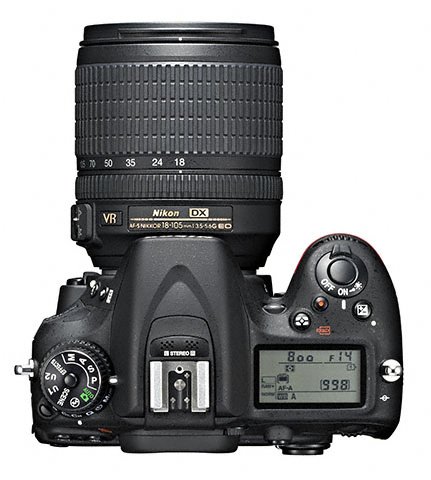
The D7100 is a well-built camera that certainly doesn’t feel like a low-end shooter. Other than its rather compact size, it feels like it is built for professional use. Because the camera has a partial magnesium alloy frame, it feels much sturdier than the lower-end cameras that are fully plastic. Paired with the Nikon MB-D15 battery grip, the D7100 gets a full-size feel and really turns it into the feel of a more serious camera.
The typical Nikon controls are present on the external body of the D7100 with a few changes from the D7000, which include a lockable mode dial and some layout adjustments.
As with other Nikon DSLRs, the dual control wheels operated by the user’s right thumb and forefinger are excellent at gaining quick access to common adjustments. Access to drive modes is also retained as a dial the surrounds the main mode dial – again, a nod to the “pro” side of this prosumer camera.
Shooting with the Nikon D7100
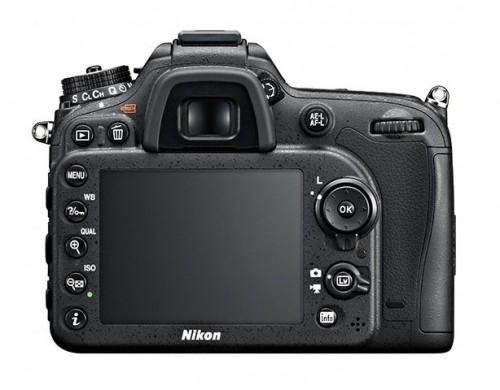
Quite simply, the Nikon D7100 is a joy to use. It is responsive in terms of its controls as well as autofocus speed and accuracy. Paired with the Sigma 17-70mm f/2.8-4 DC lens, I was not let down by the D7100’s autofocus speed or accuracy.
Being a Nikon, the D7100 features exposure autobracketing, which makes it simple to capture multiple exposures of the same scene for combination in HDR software.
The biggest letdown for me was the internal buffer when capturing images in rapid succession. Apparently, the processor within the D7100 is not quite powerful enough to chew up the large 24MP raw image files when you are shooting at the full 6fps that the D7100 offers. Unfortunately, it is only capable of capturing 6 raw image files before the buffer fills up and image capture slows to a crawl.
Other than the buffer issues, I really have no complaints about still image capture with the D7100. The lack of an anti-aliasing filter produces sharp images and Nikon delivers surprising high ISO quality at a very high resolution.
Nikon D7100 Video Features
Above is a bit a sample footage that I shot with the D7100. There were a lot of great little scenes down by these tracks where the homeless drunks make their home.
The D7100 is a solid little camera for HDSLR video capture, albiet with a few quirks.
Moire is definitely an issue with the D7100, but this is really nothing new for the HDSLR format. From what I have seen, some of the newer and higher-end HDSLRs do a much better job, but the D7100 is line-skipping on a smaller APS-C sensor with 24-megapixels, so that is bound to exacerbate the problem. Likewise, the absence of an optical low-pass filter likely enhances the problem.
The widely documented aperture adjustment issue is very frustrating, particularly so for Canon users who are accustomed to changing aperture while live view is active (or even when recording). This was a problem with the D7000 and continues to be an issue with the D7100. Nikon needs to add the ability on its HDSLRs to adjust lens aperture while live view is active and stop forcing users to exit live view, change aperture settings and then reactivate live view.
Those issues aside, the D7100 is a great HDSLR camera. The inclusion of a headphone output jack and uncompressed HDMI-out are two huge features on such a low-end camera.

All of the shots in the above video were with the new Sigma 17-70mm f/2.8-4 DC OS HSM lens, which seems to be an excellent all-purpose lens for the D7100 – for both stills and video. Seriously, this is a solid lens and one that I recommend for any APS-C shooter. I also had a variable ND filter on the lens to control the depth of field.
Additionally, the shots were either handheld or with a slider. While the lens’ optical stabilization performed admirably, the handheld shots were further stabilized using the Warp Stabilizer effect in Premiere Pro CS6.
To give you a taste of how the Sigma 17-70mm lens’ optical stabilization performs with any additional stabilization in post production, take a look at the following brief video that compares a scene shot handheld at 70mm with and without optical stabilization activated on the lens.
Nikon D7100 Image Quality
This first round of images covering the ISO range were processed as RAW files in Lightroom and exported as JPEG. I did no additional edits. White balance was set to Auto under tungsten lighting.

The above 100% crop samples were taken from the scene shown in the following images.
Feel free to download any of these sample images for your personal inspection (not for republication). You can get the original files by right-clicking on any of the images and choosing “Save link as…”
Note that some of the below images have received some adjustments in Lightroom 4 to my own personal preferences and tastes.
Overall, I have been very impressed with the image quality from the Nikon D7100. Throughout my time with the camera, I was continually wowed by what Nikon was able to do with 24-megapixels on the smaller DX-format sensor.
Particularly, the RAW files are more impressive than what I have been accustomed to seeing on Canon’s various flavors of 18MP APS-C sensors.
Nikon D7100 Accessories
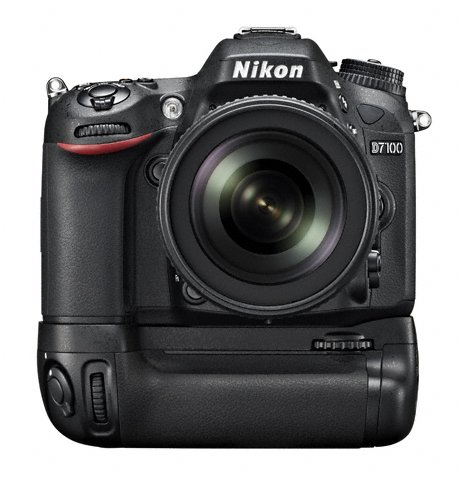
Nikon EN-EL15 Battery – The Nikon D7100 comes with one of these rechargeable lithium-ion batteries; however, if you’re going to be away from power for an extended period, you can pick up spares.
Nikon MB-D15 Battery Grip -If you are looking for more power or just more control in the portrait orientation, the MB-D15 is the grip to fit the Nikon D7100. It comes with two battery trays – one for the EN-EL15 and one for 6 AA batteries. Just make sure you grab an extra EN-EL15 battery to go with MB-D15 as it does not include the battery itself.
Nikon SB-700 Speedlight -The SB-700 is hot shoe Speedlight and it currently occupies the “enthusiast” segment for Nikon Speedlights. Since the D7100 can be operated in commander mode with the built-in pop-up flash, adding a SB-700 Speedlight is a great tool to get the flash off the camera.
Nikon SB-910 Speedlight -The SB-910 is the current king of Nikon Speedlights. If the SB-700 doesn’t have enough to suit your needs, the SB-910 is the cream of the crop.
Nikon WU-1a Wireless Mobile Adapter – With the WU-1a, images captured by the D7100 can be transferred to any compatible Android/iOS device.
Sigma 17-70mm f/2.8-4 DC OS HSM Lens – As noted above, this Sigma lens is designed for APS-C sensor cameras like the D7100. And it makes a perfect kit lens alternative to what Nikon offers. It’s a fast lens at f/2.8 on the wide end and f/4 on the long end. The fast lens design mates well with the D7100’s prowess in low light.
Conclusions
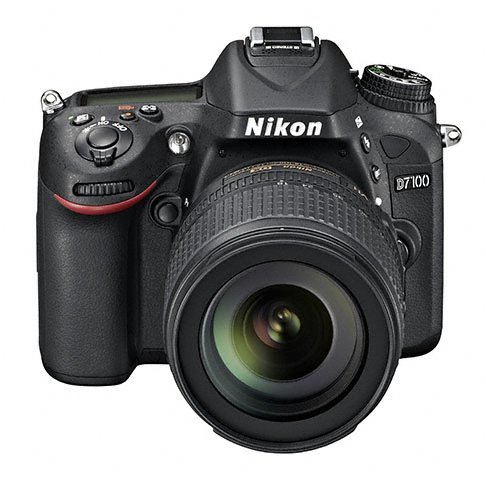
The Nikon D7100 is a powerful prosumer camera that will deliver more than enough to most users. The only folks who should weigh carefully their decision to purchase the D7100 are those who plan on shooting lots of pro-level video and/or shooting sports or wildlife in 14-bit raw due to the video and buffer issues, respectively, noted above.
Those minor issues aside, the D7100 provided the best overall experience that I have had with any APS-C DSLR to date. Highly recommended.
The Nikon D7100 is available from Photography Bay’s trusted retail partner, B&H Photo, at the following link:
By making your photography purchases at B&H Photo through these links, you are helping Photography Bay to continue bring quality camera tests, news and reviews. Thanks for your continued support.
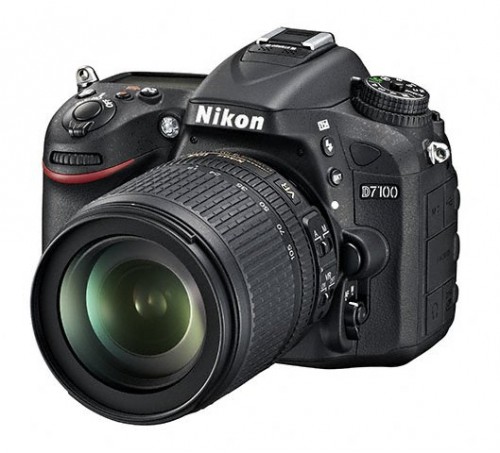























The 6 shot RAW buffer means the thing is utterly useless.
Nice review…Right on with what I observed as well. I also compared the D7100 directly with the Canon 7D for video and found that the D7100 performed much better with better sharpness and way better low light performance. If only it wasn’t for not being able to control the aperture while shooting. Imagine shooting a wedding and following the bride from indoors to outdoors while recording without aperture control. It’s impossible! So unfortunate because the D7100 blew away the Canon 7D in every other area but I don’t think you could ever use the D7100 for live video recording where lighting conditions may change.